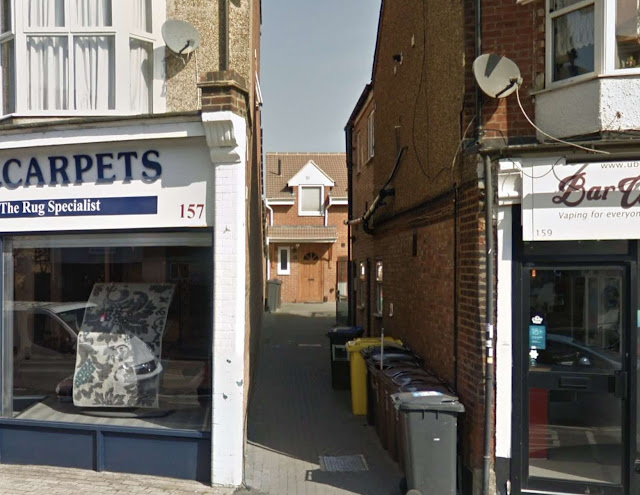 |
| These are the premises described below, between 159 Hatfield Road and Harlesden Road corner, bounded by the red line. COURTESY GOOGLE EARTH |
The previous post, Squeezing One More In, demonstrated that the need to add more accommodation to the Fleetville streetscape is not a new concept and began early on. The first properties to call on this time are 159 and 161 Hatfield Road. As with so many addresses this building was a semi-detached pair, built by George Emerton, who also put up the Oak Villas (numbers 139 and 141) among other homes. Both of the original tenants realised, as had others along the road, that there was commercial advantage in gaining permission to convert their homes into shops with flats above; Mr Bennett sold provisions, and Mr Guy was a milliner. They were both the first occupiers. Below are two photos of this pair of former homes, the first taken in 2012, while the other is very recent. Notice the difference? In the back garden space accessed from the driveway between 157 and 159, a new house has been added – yet one more squeezed in! Two long-term trades and tenants may be recalled by older residents. Mr North managed a wet fish shop, while from the same shop space Mrs North sold fruit and veg. There were occasions in the 1950s when your author recalls walking home with one of the North children, being invited to the flat above and being offered an item of fruit on the way. Even today number 159 is divided. Next door was a chemist, run first by Mr Pike and then Mr Kine; today it is a charity shop.
Moving on, below is an example of a pair of homes which remain residential addresses, even retaining their individual tiny front gardens. Together with the shop numbered 167, all were owned by Frank Sear. Mr Sear ran a dairy shop. Built into the premises was a covered driveway to give rear access between the cottages and the shop. The photograph below shows this drive with a wide door at the street end. Today it has been converted into a narrow shop; a Thai Takeaway. Even Mr Sear's former shop has a narrower frontage today to give independent access to a first floor flat.
 |
| In 2012 the centre shop is the former Henry Sear shop; the narrow shop to its left was the gated driveway to the rear. |
The next property, number 169, was a side-by-side pebble-dashed detached building, having residential rooms on the left and shop on the right; the shop beginning life as a butchery run by Walter Aldridge. However, for a few years prior to World War One, Miss Moore ran a cafe ("Dining Rooms"), and one of the two ladies standing at the shop doorway was undoubtedly Miss Moore, whose name hung on a horizontal boom flagpole, no doubt to attract attention. From the 1920s and for the next 70 years or so it was known as Townsend's. Useful for the early days of radio (and later television), Mr Warner and then Mr Leslie Townsend, sold components, and batteries, undertook repairs, charge up accumulators, and then widened the trade to include bicycles. From an "alladin's cave" of a store room at the back many customers will have recalled absence from the shop for what was thought to be a long period until, finally, a spare part was located.
 |
| A 1970 shot of Mr Townsend's shop and the corner shop as a heating engineer. |
 |
| A different view of Townsend's shop, now a charity shop, and the earlier boot shop and heating engineer, now a beauty salon. |
On the corner with Harlesden Road a shop with diagonal entrance was opened in 1903 for bookmaker H Copus & Son. In fact, Horton's and then Samuels, also boot and shoe makers, repairers and retailers, continued to thrive on this corner until around 1970, when major improvements were encouraged in the heating of homes and other buildings. T A Horn had an important local part to play in this trend. Walk around to the side elevation in Harlesden Road we note some colour relief to the brickwork was achieved by introducing occasional lines of red bricks instead of stocks, a similar effect being used around the windows and doorway. The former garden has also been used entirely for additional ground floor accommodation. We should remind ourselves that, in laying out the plots at the turn of the twentieth century it was with the building of residential accommodation, not shops, in mind. One of the original blue enamel street plates, fixed by the rural council to designate Harlesden Road in 1906, is still visible at first floor level.
In the event that some readers may be carrying out their own research into Hatfield Road developments and discover that the address numbers used here do not correspond with their own findings, the original numbers were allocated when there was still much undeveloped land and the Post Office resorted to guessing how many to reserve for future use. It was not until 1930 that a revised numbering plan was prepared and activated the following year.
Next time we will discover the story of one of the politically most controversial events in Fleetville's early history.




No comments:
Post a Comment